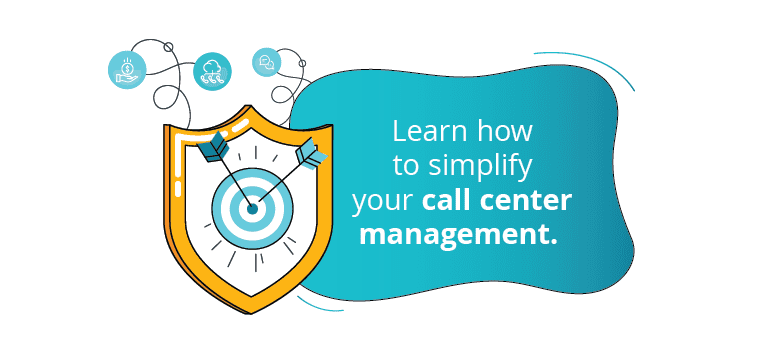Meet Emma. She’s been the top-performing agent in a software company’s virtual call center, set apart by her exceptional customer service skills and knack for solving the trickiest problems. So, when her boss got a promotion, it made sense for Emma to step up to become a manager.
On her first day as manager, the call center is bustling with ringing phones and chatter. But this time, she isn’t going to her desk as an agent. Now, she’s in charge.
Pretty soon after logging in for the day, there’s a queue of agents who need her help. They all have their own urgent problem. Her inbox fills with tasks. Reports need to be analyzed. Performance metrics need to be compiled and tracked. A new hire starts tomorrow — who will train him? On top of all this, she has to handle the customer complaints that have escalated to her.
Managing a virtual call center is no joke. Managers like Emma face the daunting task of navigating a complex and demanding environment with poise and efficiency. Where do you start?
These 15 best practices can help you boost efficiency, support your team, and take on your call center responsibilities like a boss.
15 Best Practices to Help You Manage Your Virtual Call Center
1. Hire the Right People
Globally, virtual call centers are plagued by high turnover and attrition rates. For the past five years, turnover rates in call centers have remained between 30% and 40%, making them some of the highest across all industries. While it can be tempting to do just about anything to fill those empty seats as quickly as possible, it’s crucial to hire the right people. After all, losing employees can cost you.
Nearly 65% of customers said they have changed to a different brand because of a poor experience. And when you hire the right people (the first time), you’re more likely to sustain high-quality customer experiences. Don’t let a bad hire drive away revenue. Instead, look for agents with strong soft skills who are eager to learn and grow. When you hire well, your customers, team, and bottom line will thank you.
2. Cultivate a Strong Team Culture
The quality of your team culture matters. In fact, it can help drive engagement and stop attrition. Workers who feel strongly connected to their team are 55% less likely to look for other job opportunities. And they’re 5.2 times more likely to recommend their organization to others.
So, how do you build a culture that agents want to be part of?
Start with open communication and inviting curiosity and questions. You can promote team bonding by doing fun things outside work hours, whether in person or virtually. Set clear goals and celebrate achievements when those goals are met. Most importantly, stay humble and show your own desire to learn, grow, and accept feedback.
3. Properly Train Your Agents
Set your team up for success with ongoing and consistent training. Ensure they’re well-versed in your products, services, and customer service protocols. Then, host review sessions and role-play different scenarios to keep your team sharp. Ensure everyone knows about new processes and tools and review performance analytics and call recordings for focused coaching.
Here are more tips for coaching effective agents.
4. Create an Effective Onboarding Strategy
The first 30 days on a job can make or break an employee’s experience. Upwards of 70% of employees will stay at a company for at least three years if they have a great onboarding experience.
Partnering with your HR team to create a robust onboarding process is essential. Onboarding sets the tone of your culture, supports faster learning, and helps agents establish important friendships and acclimate. Be sure to give new employees the right resources, introduce them to key team members, and set clear expectations from the start.
5. Reward, Motivate, and Incentivize Your Agents
Employees tend to work better — and harder — if there’s a benefit to them. Companies are fighting for good talent, so you can’t risk losing top performers because you overlooked their good work. You can retain more agents and encourage good work through rewards and recognition. Try giving shout-outs for exceptional performances and providing bonuses or gifts. This incentivizes agents and improves engagement.
6. Create a Customer Feedback Strategy
Your customers are the reason you do your job. As such, they should be the center of your strategy. For this reason, gathering feedback and listening to your customers is essential for continuous improvement. Send surveys to your customers and assign agents for follow-up. Then, with a feedback loop in place, you’ll know how to serve your customers better, boosting customer satisfaction.
7. Monitor Agent Performance
You can grow as a manager by helping your agents improve their performance. By regularly monitoring performance, you can identify strengths and areas of improvement.
Use performance data and call recordings to provide constructive feedback during your one-on-ones. You can coach agents throughout the day to enhance their strengths and improve their weaknesses in real time. And then, you can tailor training programs to address specific needs.
8. Ask Your Agents for Feedback
Every good boss I’ve had shares one quality: they’re humble. And good leaders demonstrate their humility by asking their team for feedback.
Your agents are on the frontline every day. They see the ins and outs of your virtual call center and have valuable insights into customer interactions and internal processes. If you want to improve your team, regularly ask for their feedback to understand their challenges and identify opportunities for growth.
9. Update Your Collaboration Tools
When communications break down, everyone suffers — especially your agents and customers. And when everyone works remotely, like in a virtual call center, you need tools that make effective collaboration possible.
Update your tools to streamline communications and enhance teamwork. With a collaboration tool like b-hive, your agents can make voice and video calls, chat with other teammates, and check their status from one unified platform.
Learn more about the b-hive virtual call center.
10. Invest in the Right Cloud Software
Flexibility and scalability are essential when managing a virtual call center. You need the right tools to make things work efficiently. Things won’t run smoothly if your cloud software is outdated and hard to use. Investing in the right cloud software alleviates stress on your agents, enabling them to deliver better service.
For the best results, find a user-friendly platform that scales with you, includes robust call routing, and integrates with your existing software.
11. Use WFM to Assess Your Staffing Needs
Managing staff and scheduling is a top priority for virtual call center managers. How do you ensure you have the right number of agents with the right skills available at the right times?
Workforce management software helps you analyze staffing needs based on call volume patterns. Proper staffing ensures you can handle peak times without overburdening your agents or keeping customers waiting. WFM can help you predict future needs for a more efficient call center.
Learn more about finding the right workforce management system for your call center.
12. Invest in an IVR System
An IVR system can handle basic customer inquiries. With IVR and IVAs, you can expand your self-service options for customers (who prefer it, by the way). Then, by offering better self-service, agents are free to tackle more complex issues that require their unique strengths and skills.
IVR systems also enable call routing, ensuring customers reach the agent who is best suited to help them. This enhances efficiency and improves customer satisfaction.
13. Track Your Metrics and KPIs
Monitoring key performance indicators (KPIs) like call resolution time, customer satisfaction scores, and first call resolution rates is crucial in a virtual call center. Metrics and KPIs reveal key insights into your agent’s performance. But they also help identify gaps in processes, technological inefficiencies, and hiccups in the customer journey.
Tracking metrics can help you make more informed decisions in your daily operations. With data-backed trends in your back pocket, you have the info you need to build strategies and improve service.
14. Add AI and Automation
Integrating AI and automation into your virtual call center can streamline operations. AI voice agents (like Broadvoice’s Go.AI) can help your team handle routine inquiries. Customers can also get help faster, and your service can scale. Plus, agents can use their skills to handle more engaging and complicated customer problems. With AI and automation, you can cut back on the tedious and redundant work that burdens your agents and boost efficiency.
15. Create Detailed Call Scripts
Consistently delivering good service can be difficult to maintain. Remember Emma’s crazy list of responsibilities? Yours is probably even longer. Managers don’t have the time or capacity to track what every agent says on any given phone call (nor should they). However, without micromanaging, managers can still help agents know what to say and when to improve service using call scripts.
Well-crafted call scripts provide a consistent framework for agents to follow. They ensure that agents convey the right information and maintain a professional tone during customer interactions. By creating detailed scripts and updating them based on customer feedback, you can address evolving customer needs and maintain a high service level.
Schedule a demo with one of our consultants to learn more about our virtual call center technology.












